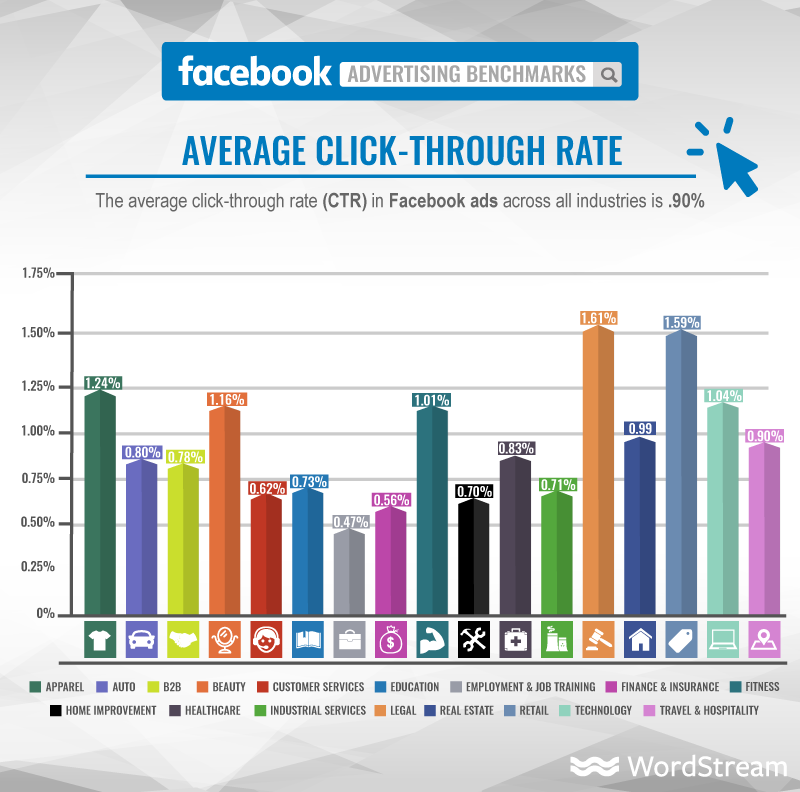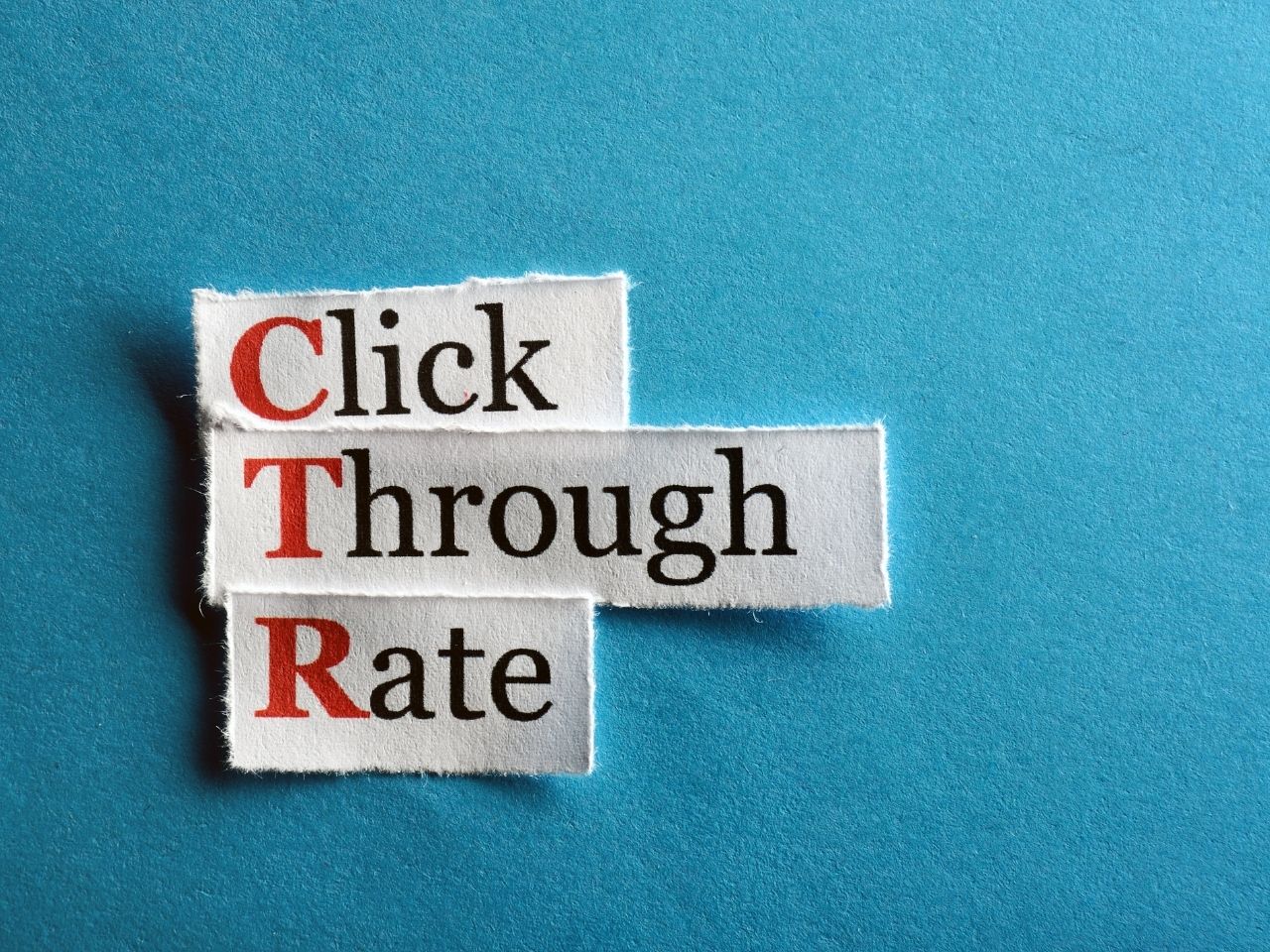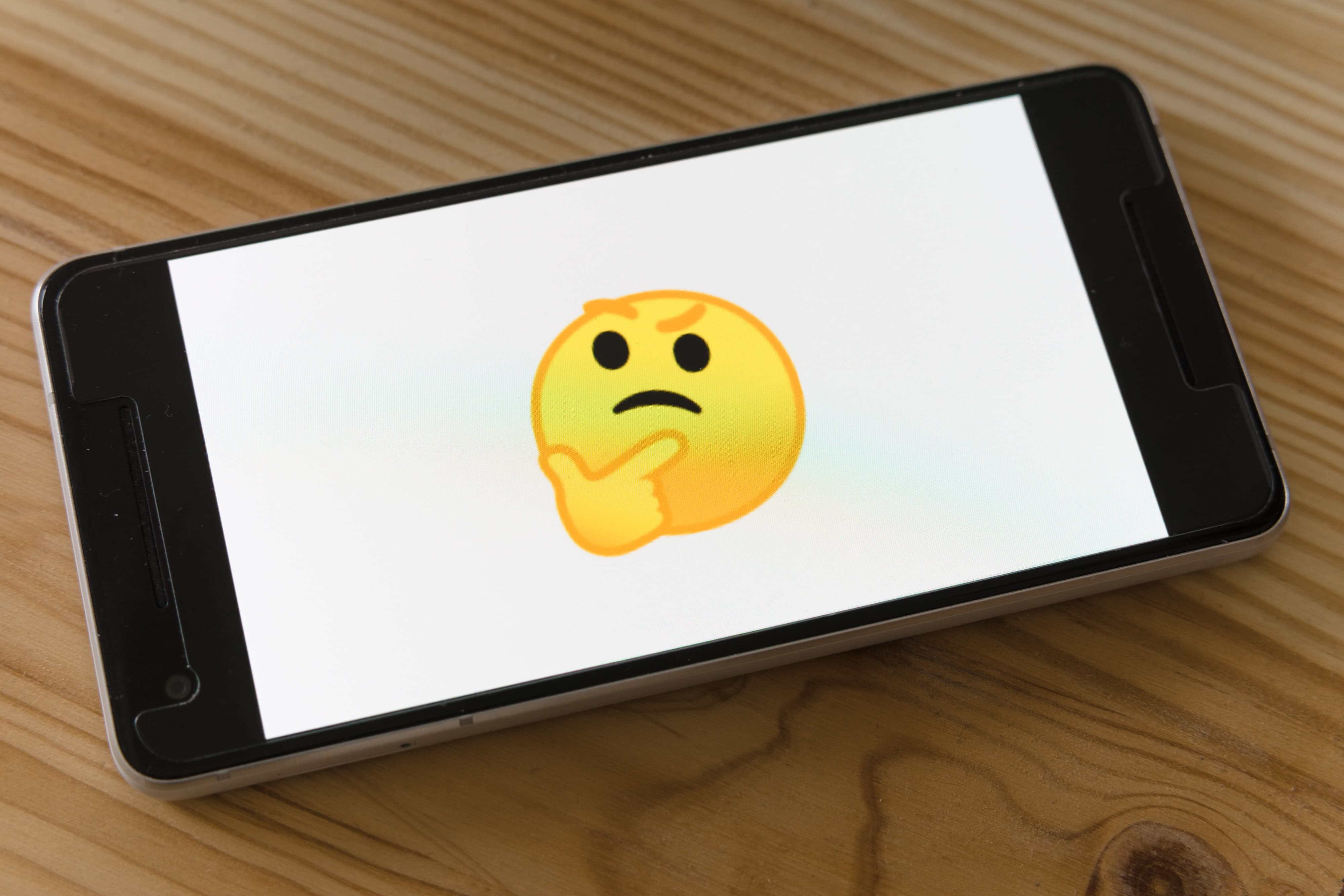Understanding who your customers are, what they like and the impact that your marketing campaigns have on them can be determined by many metrics. And this number of metrics increases when you consider the type of growth marketing campaign you wish to use. When it comes to your Facebook Ads campaigns, one of the most important to look at is your click-through rate (CTR).
What is CTR in Facebook Ads?
This metric determines the percentage of people who have clicked on your link and landed on a destination page, such as a landing page or webstore. These links can come from many sources, including ads, email and social media.
According to Wordstream, a good CTR for Facebook Ads averages at around 0.90% across all industries. Naturally, this number will fluctuate when you look at the average Facebook Ads CTR by industry, with sectors such as legal and retail able to get anywhere up to 1.61% and 1.59% respectively.
Here is how calculate your CTR: CTR (x) = [Total clicks on the ad] / [Total impressions]

Image: Facebook Ads CTR benchmark. Source: Wordstream
Naturally if your CTR is above 0.90%, then you’re doing a great job. But it can still be improved! Let’s dive into the best techniques you can start on now!
1. Headlines and experiments with them
Your headline will be one of the first contact points you have with your audience. When used well, they should complement the information found in your Facebook ad’s media, whether that’s video, image or something else (we’ll look at this more later).
So, what makes a successful headline? There’s no clear answer to this, because it will all depend on your goals, your audience, and the value you’re trying to provide. However, there are a few values with which you can craft a strong headline.
These include:
- Personalized language: This includes words like “you” and “your”, or specific demographic information (for instance, a makeup brand might appeal to “beauty lovers”)
- Keep them at the right length: You may have seen recommendations to keep your headline between 60 to 100 characters. However, Facebook itself recommends a length of 25 to 40 characters, which can be difficult to meet. So, try both and see which works for you!
- CTA in the headline: One great place to tell your audience what next step to take is in the ad headline itself – after all it does take up a large portion of the ad, meaning that its visibility is high.
- Numbered titles: While many may see them as clickbaity, from a marketing perspective you cannot deny that it’s a strategy that many companies use (and have even built businesses off like Buzzfeed)! Moz shows that a number increases CTRs by up to 36% – so start today by creating a listicle, adding a year to your ad or by offering a discount!
Tip: Sometimes one headline won’t get as good an impact as another. Have a few ready and cycle through them until you find the best fit.
2. Imagery that goes with headline or speaks volumes
Can your audience look at your ad’s image and immediately understand what the ad is about and who it is from? If the answer is no or maybe, then your imagery isn’t strong enough to succeed.
The best visuals will give the user all they need to know, and share your brand’s style in a way that connects and engages them to the content. Because after all, if you jumped on Facebook and saw an ad from your favorite brand that you thought looked ugly or boring, you’d probably ignore it before you even had a chance to realize what it was about!
So, what does a good image look like? It’ll depend on your audience and the message you’re trying to convey, but there are a few quick tips that can be applied to any image (even those you’re not using on Facebook).
- Keep your image text to a minimum. Try to keep your message short but understandable. Facebook states that pictures with less than 20% text get better results.
- Keep your imagery varied. Don’t be afraid to use alternate forms of media like GIFs, video and carousel ads. Test what works, and when you find the best performer, be sure to optimize it to improve your Facebook Ads CTR!
Tip: Use your brand style guide to create images that make your brand memorable. If your audience doesn’t see your ad and remember that it’s from you, then you need to try again.

3. Low text copy
One of the most important things to remember when creating Facebook Ads is that your ad space is limited.
In fact, a study by Track Social showed that shorter Facebook posts had a much higher engagement rate than their longer counterparts. But why do shorter Facebook posts work so much better?
We’ve all heard the saying that the human attention span is only seven seconds long. When it comes to marketing this is true – but it is even more true for social media. The faster you can communicate the value of your offer, the better. Simply put, the longer your copy is, the more likely your audience is to scroll past before you’re able to get to the part that’s meant to convince them.
Tip: Avoid jargon and slang – deliver important information without overcomplicating things to connect with your audience faster.
4. Emojis
Emojis are a massive part of social media, so why not use them in your advertising?
Many brands fall short on this Facebook marketing technique for one main reason: they believe that emojis are unprofessional and are better suited to teen chat groups. But they couldn’t be more wrong.
Why? Because emojis boost engagement! But before you start jamming emojis into your campaigns, let us teach you why they’re important and how to manage them.
- Facebook emojis capture attention. They can help highlight important information by adding color to an otherwise black and white piece of copy, and can even add a personal touch.
- Saved space. As we just mentioned, the Facebook ads that receive the most engagement are shorter in length. Like they say, a picture is worth a thousand words!!
- Clear messaging. Sometimes it is easier to show than explain. An emoji can communicate on a deeper emotional level than text can, as they share messages we can all understand as humans. This has even more impact when you consider language barriers.
- Natural advertising. You don’t want your ad to seem like an ad. Using emojis can help them appear as friendly, conversational posts rather than a stock-standard ad. It’s all about that human touch.
Tip: Emojis should not be overused. Using too many emojis can complicate your messaging and make it appear that you are trying too hard to be relatable. Keep it natural, and if it seems like too much – it probably is!

5. Questions
Most people won’t get intrigued from a statement you make. But luckily, you can pique their interest by posing interesting questions that have them wanting to find out what happens next.
We get it – generating curiosity is difficult. But like the season finale of your favorite TV show that just announced an upcoming season, you’ve got to get your audience excited to see more.
A good way to start creating excitement is to analyze your industry and see what questions people are asking. If you’re a B2B business, a strong ad might say something like “What if you could make your workflow 150% more efficient?” or “How do I increase my organic traffic easily?”
Of course, your questions must play into your audience’s interests and the products and services that you offer. Tweak your wording, make your content impactful and show how your business above all others is able to answer any burning questions that your potential customers may have.
Tip: Remember what we said about image text above! Keep your questions short, succinct and to the point.
6. Very strong CTAs
While valuable content is a great start, a good CTA is your final push to convince your audience to take the next step. Without a CTA your audience will see your ad but will not know how to take action. Or they simply might not be persuaded enough! Whether your ad campaign goal is to increase your brand awareness, sell your product, or generate leads, your CTA is the driving factor that gets your potential customers to take the next action.
One of our best tips for making your CTAs persuasive is to include action verbs in them. These includes words such as “try, start, learn, get” and can be very convincing at making the next step in your offer an obvious choice to make
CTAs that use action verbs include:
- Talk to us
- Get started
- Try for free
- Learn more
- Sign up for free
- Subscribe now
- Claim your free trial
Tip: Customize your CTA to your audience and your advertising to take it to the next level!

7. Audience targeting
If people see your ad and aren’t interested in engaging, what was the point of targeting them in the first place? Luckily, Facebook Ads has detailed targeting parameters that helps businesses narrow down their audience and connect with the right people.
Instead of shooting for a broad audience, think to yourself: “What kinds of people are going to be interested in my ad?”. Once you’ve narrowed the types of people you want to target, exclude those you don’t with Facebook’s parameters which allow you to exclude people by interests, behavior, and demographic information. You can even create Custom Audiences and exclude those, which will help you set up future campaigns with ease.
Tip: Include the people you want and exclude those you don’t! Having information in each of these targeting parameter fields will help Facebook more closely align your ads with the right people.
8. Ad formatting
There are a bunch of ways to create an ad on Facebook. But it doesn’t mean you should pick one without first considering the impact it may have on your returns. Let’s take a look at the most common ad formats, and when you should use them.
Single images
One of the most common Facebook ad formats, single images are the easiest to develop and some of the best at getting results. These are best used for simple tasks such as driving website traffic, promoting offers, or encouraging people to message your team.
Image carousels
Carousels are a collection of images, set up in swipe format. These are best implemented to allow users to browse your catalog or see why your business is the best choice.
Facebook Collections
A newer introduction by the social media giant, Collection ads make it easier for people to learn more about and purchase products and services while being immersed.
This format features a cover image or video followed by three product images. When a user clicks an image, they’ll be transported to an Instant Experience – a full-screen promo section that opens to show more and nurture engagement. This feature can only be accessed on mobile devices, and is best used for businesses that wish to promote further to their audience in the convenience of the Facebook app..
Dynamic ads
These automatically show products to people who have expressed interest previously, creating a personalized advertising experience that is unique to each user. They also update in real time, meaning that you’ll only need to set up your campaign once for it to reap rewards. This is good for businesses wishing to retarget users.
Boosted posts
Perhaps the simplest way to create an ad, boosting an existing post will help it reach a wider audience. This is best used on posts which have already gained some traction and have value for your wider audience.
Tip: While some of these sound easier than others, don’t take the easy way out! Developing the best ad campaign can increase your Facebook Ads CTR, performance and revenue – if you take the time to test out your opportunities.

Want to perfect your paid ads?
There are lot of paid advertising strategies you can use, and it can be hard to choose the right one. But don’t worry! We’ll help you invest your ad spend wisely with our guide – Paid Advertising 101: How to Grow Your Business With the Right Ads.
Facebook Ads is an extraordinary tool for you to achieve your marketing goals. But Facebook Ads has a steep learning curve.
By implementing the steps above, you have the ability to customize and tweak your Facebook Ads campaigns to generate higher customer engagement.
But if you’d like to take it to the next level, partnering with an accomplished growth marketing agency can help you optimize your Facebook Ads to achieve optimal CTR.
Growth Marketing Genie is a professional Facebook Ads agency that has a team of experts that can do all this and more to provide proven results to your business.
Book in a Free Consultation
